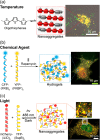Polymer Chemistry in Living Cells
- PMID: 36178462
- PMCID: PMC9583600
- DOI: 10.1021/acs.accounts.2c00420
Polymer Chemistry in Living Cells
Abstract
The polymerization of biomolecules is a central operation in biology that connects molecular signals with proliferative and information-rich events in cells. As molecules arrange precisely across 3-D space, they create new functional capabilities such as catalysis and transport highways and exhibit new phase separation phenomena that fuel nonequilibrium dynamics in cells. Hence, the observed polymer chemistry manifests itself as a molecular basis leading to cellular phenotypes, expressed as a multitude of hierarchical structures found in cell biology. Although many milestone discoveries had accompanied the rise of the synthetic polymer era, fundamental studies were realized within a closed, pristine environment and that their behavior in a complex multicomponent system remains challenging and thus unexplored. From this perspective, there is a rich trove of undiscovered knowledge that awaits the polymer science community that can revolutionize understanding in the interactive nanoscale world of the living cell.In this Account, we discuss the strategies that have enabled synthetic polymer chemistry to be conducted within the cells (membrane inclusive) and to establish monomer design principles that offer spatiotemporal control of the polymerization. As reaction considerations such as monomer concentration, polymer growth dynamics, and reactivities are intertwined with the subcellular environment and transport processes, we first provide a chemical narrative of each major cellular compartment. The conditions within each compartment will therefore set the boundaries on the type of polymer chemistry that can be conducted. Both covalent and supramolecular polymerization concepts are explored separately in the context of scaffold design, polymerization mechanism, and activation. To facilitate transport into a localized subcellular space, we show that monomers can be reversibly modified by targeting groups or stimulus-responsive motifs that react within the specific compartment. Upon polymerization, we discuss the characterization of the resultant polymeric structures and how these phase-separated structures would impact biological processes such as cell cycle, metabolism, and apoptosis. As we begin to integrate cellular biochemistry with in situ polymer science, we identify landmark challenges and technological hurdles that, when overcome, would lead to invaluable discoveries in macromolecular therapeutics and biology.
Conflict of interest statement
The authors declare no competing financial interest.
Figures







Similar articles
-
Controlled Supramolecular Polymerization via Bioinspired, Liquid-Liquid Phase Separation of Monomers.J Am Chem Soc. 2024 May 8;146(18):12577-12586. doi: 10.1021/jacs.4c01377. Epub 2024 Apr 29. J Am Chem Soc. 2024. PMID: 38683934
-
Macrocycle-Based Solid-State Supramolecular Polymers.Acc Chem Res. 2022 Apr 5;55(7):1025-1034. doi: 10.1021/acs.accounts.2c00011. Epub 2022 Mar 24. Acc Chem Res. 2022. PMID: 35321546
-
Multinuclear group 4 catalysis: olefin polymerization pathways modified by strong metal-metal cooperative effects.Acc Chem Res. 2014 Aug 19;47(8):2545-57. doi: 10.1021/ar5001633. Epub 2014 Jul 30. Acc Chem Res. 2014. PMID: 25075755
-
Supramolecular Polymerization from Controllable Fabrication to Living Polymerization.Macromol Rapid Commun. 2017 Sep;38(17). doi: 10.1002/marc.201700312. Epub 2017 Jul 28. Macromol Rapid Commun. 2017. PMID: 28752583 Review.
-
STEREOSPECIFIC POLYMERIZATION. A REVOLUTION IN POLYMER SYNTHESIS HAS OCCURRED IN THE LAST DECADE.Science. 1964 Aug 14;145(3633):667-73. doi: 10.1126/science.145.3633.667. Science. 1964. PMID: 14163799 Review.
Cited by
-
Cascade Mesophase Transitions of Multi-enzyme Responsive Polymeric Formulations.Biomacromolecules. 2024 Jun 10;25(6):3607-3619. doi: 10.1021/acs.biomac.4c00221. Epub 2024 May 22. Biomacromolecules. 2024. PMID: 38776179 Free PMC article.
-
Organelle-like structural evolution of coacervate droplets induced by photopolymerization.Nat Commun. 2025 Feb 20;16(1):1783. doi: 10.1038/s41467-025-57069-1. Nat Commun. 2025. PMID: 39971992 Free PMC article.
-
Light-Controlled Intracellular Synthesis of Poly(luciferin) Polymers Induces Cell Paraptosis.J Am Chem Soc. 2025 Jan 15;147(2):2037-2048. doi: 10.1021/jacs.4c15644. Epub 2025 Jan 5. J Am Chem Soc. 2025. PMID: 39757486 Free PMC article.
-
Supramolecular Assembly in Live Cells Mapped by Real-Time Phasor-Fluorescence Lifetime Imaging.J Am Chem Soc. 2024 May 1;146(17):11991-11999. doi: 10.1021/jacs.4c01279. Epub 2024 Apr 19. J Am Chem Soc. 2024. PMID: 38639465 Free PMC article.
-
Synthetic control of living cells by intracellular polymerization.Trends Biotechnol. 2024 Feb;42(2):241-252. doi: 10.1016/j.tibtech.2023.08.006. Epub 2023 Sep 23. Trends Biotechnol. 2024. PMID: 37743158 Free PMC article. Review.
References
-
- Zhou Z.; Maxeiner K.; Moscariello P.; Xiang S.; Wu Y.; Ren Y.; Whitfield C. J.; Xu L.; Kaltbeitzel A.; Han S.; Mucke D.; Qi H.; Wagner M.; Kaiser U.; Landfester K.; Lieberwirth I.; Ng D. Y. W.; Weil T. In Situ Assembly of Platinum(II)-Metallopeptide Nanostructures Disrupts Energy Homeostasis and Cellular Metabolism. J. Am. Chem. Soc. 2022, 144, 12219–12228. 10.1021/jacs.2c03215. - DOI - PMC - PubMed
-
- Breslow R. Biomimetic Chemistry and Artificial Enzymes: Catalysis by Design. Acc. Chem. Res. 1995, 28, 146–153. 10.1021/ar00051a008. - DOI
Publication types
MeSH terms
Substances
LinkOut - more resources
Full Text Sources
Research Materials

